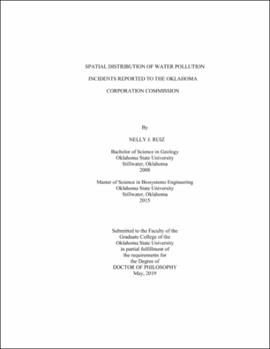| dc.contributor.advisor | Weckler, Paul | |
| dc.contributor.author | Ruiz, Nelly J. | |
| dc.date.accessioned | 2021-10-21T15:42:52Z | |
| dc.date.available | 2021-10-21T15:42:52Z | |
| dc.date.issued | 2019-05 | |
| dc.identifier.uri | https://hdl.handle.net/11244/331143 | |
| dc.description.abstract | The increase in high volume hydrocarbon production in Oklahoma raised concern about the potential adverse environmental effects and more specifically the contamination to surface and ground waters. Despite the complexity of the debate encompassing this topic, there has been limited quantitative information presented to the public on actual impacts. Publicly available databases in Oklahoma indicate very infrequent or no contamination of groundwater has been reported alluding responsibility to the oil and gas industry. However, firm conclusions are hindered by the gaps and uncertainties in the raw data. The goal of this research was to manually sort through five years of state data to quantify and evaluate the spatial distribution of actual occurrences. In order to facilitate interpretation of the raw disorganized database it was necessary to classify the incidents into five categories including accidents, misconduct, non-producing, health and other. These categories were further divided into 12 subcategories of which the affected surface and ground waters were extracted for evaluation. The literature suggests that these waters may be directly affected by unplugged wells and produced fluid spills. For this reason, the locations of these two subcategories were geocoded to assess the spatial distribution in ESRI Geographic Information System (GIS). It was found that 203 water wells were reported polluted in five years from 2008 to 2012, of which 84 were referred for continuation and additional analysis. Produced fluid spills had occurred in 1,805 instances of which 18% were located within a vulnerable aquifer and 10% within a protected watershed. The number of unplugged wells was 1,090 with an annual average of 218. The unplugged wells and the polluted water wells were clustered in north-central Oklahoma, which coincides with the locations of historical hydrocarbon fields. Detailed and organized data is necessary to calculate the effects to water resources in the state. | |
| dc.format | application/pdf | |
| dc.language | en_US | |
| dc.rights | Copyright is held by the author who has granted the Oklahoma State University Library the non-exclusive right to share this material in its institutional repository. Contact Digital Library Services at lib-dls@okstate.edu or 405-744-9161 for the permission policy on the use, reproduction or distribution of this material. | |
| dc.title | Spatial distribution of water pollution incidents reported to the Oklahoma Corporation Commission | |
| dc.contributor.committeeMember | Brown, Glenn | |
| dc.contributor.committeeMember | Halihan, Todd | |
| dc.contributor.committeeMember | Vilcaez, Javier | |
| osu.filename | Ruiz_okstate_0664D_16265.pdf | |
| osu.accesstype | Open Access | |
| dc.type.genre | Dissertation | |
| dc.type.material | Text | |
| dc.subject.keywords | hydraulic fracturing | |
| dc.subject.keywords | produced fluid | |
| dc.subject.keywords | spills | |
| dc.subject.keywords | unplugged wells | |
| dc.subject.keywords | water wells | |
| thesis.degree.discipline | Biosystems Engineering | |
| thesis.degree.grantor | Oklahoma State University | |
